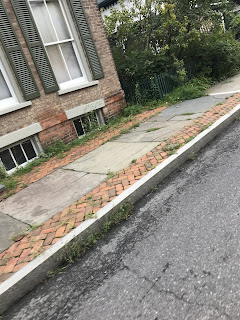The Common Council Legal Committee took up two hot topics last night: sidewalks and short-term rentals. This post will report on the discussion about sidewalks. A subsequent post will take up the discussion of Airbnbs.
Sidewalks have been a topic of conversation in City Hall for at least two decades. Not only is there the problem of broken, dangerous, and nonexistent sidewalks, there is also the problem of new sidewalks constructed in compliance with code being significantly higher than existing sidewalks. The problems of disrepair and lack of uniformity stem from the law in Hudson that makes the care and keeping of sidewalks--although they are the public way--the responsibility of the property owner not the City. Consequently, with the exception of Warren Street, where, twenty or so years ago, the brick pavers installed during Urban Renewal to make Hudson's main street look more like historic Williamsburg were replaced with concrete sidewalks, the sidewalks in Hudson are a patchwork of materials and conditions.
Last night, city attorney Andy Howard outlined essentially two courses of action the City might pursue. He also mentioned seeking CFA (Consolidated Funding Application) money, although it wasn't clear in which of the two scenarios such funding might be used. The first was what he called an "enforcement mechanism." Substandard sidewalks would be ticketed, and the owners of the adjacent properties would have to fix their sidewalk or pay a fine sufficient to cover the expense of the City fixing it.
The second would be to create a "special district," in which payment for sidewalks would be added to the property tax bill. Sidewalks would be repaired by the City every twenty years, and the property owner would be billed for it incrementally over a period of twenty years. Howard said he needed to speak with DPW superintendent Rob Perry to see "what level of fees would be required to make the plan work so that it does not bring liability to the City." At a Public Works and Parks Committee meeting back in September, Perry estimated sidewalk replacement would cost $35 per linear foot.
Howard said he would draft a proposed amendment for review at the next Legal Committee meeting and asked which option--enforcement or special district--they would prefer. Alderman Tiffany Garriga (Second Ward), who sits on the committee, asked for an example of each way to amend the law. It wasn't until after this was decided that any mention was made of materials to be utilized. Howard spoke of the bluestone sidewalks found throughout the city, some of which are original and some newly installed, pointing out that bluestone does not meet the code. This called to mind a problem Perry raised at a Public Works and Parks Committee meeting in September, when he distributed these pictures of some of the most handsome sidewalks in Hudson and asked what they had in common.
The answer was that all of these sidewalks were out of compliance with code.
The solution to our sidewalk issues will require more than just addressing issues of financial responsibility for replacement and repair but also the code requirements that create hazards for pedestrians by requiring new sidewalks to be substantially higher than existing sidewalks.
COPYRIGHT 2019 CAROLE OSTERINK









The sidewalk code should be revised to allow solutions other than...CONCRETE. For a town obsessed with historical preservation concrete isn't historic. The out of compliance walks are more historic and more attractive.
ReplyDeleteMy great-greatgrandfather's brother had a contract for the City of Chicago to build/install wood plank sidewalks in about the 1840s. This article mentions "There’s also very little physical evidence remaining of early walks. Materials eventually deteriorate and get replaced. Installation of modern, in-ground utilities can destroy early hardscapes. At the end of the 19th century, concrete was found to be ideal for paving. It was a lower cost material so it was common to use for replacement of original surfaces." http://www.oldhouseweb.com/blog/historic-sidewalks/
ReplyDeleteSome of the worst sidewalks in town are CONCRETE ... and speak for themselves.
Delete